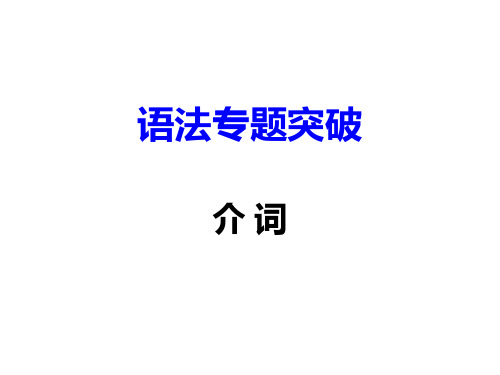介词中考专题讲义
- 格式:pdf
- 大小:22.17 KB
- 文档页数:7






介词I. 介词是一种用来表示词与词, 词与句之间的关系的词。
在句中不能单独作句子成分。
介词后面一般有名词代词或相当于名词的其他词类,短语或从句作它的宾语。
介词和它的宾语构成介词词组,在句中作状语,表语,补语或介词宾语。
II. 介词归类大全一、表示地理位置的介词:(1)at ,in, on, toat (1)表示在小地方; (2)表示“在……附近,旁边”in (1)表示在大地方; (2)表示“在…范围之内”。
on 表示毗邻,接壤to 表示在……范围外,不强调是否接壤例句:He arrived the station at ten.He is sitting the desk.He arrived Shanghai yesterday.Jiangsu lies the east of China.Russia lies the north of China.Fujian is the south of Jiangsu Province.注意:表示“树上有……”时,in和on有区别。
用on表示这个事物属于树的一部分,但是用in表示这个事物在树上,并不属于树的一部分。
练习:There is an apple the tree and a bird the tree.(2)above, over, on 在……上above 指在……上方,不强调是否垂直,与 below相对;over指垂直的上方,与under相对,但over与物体有一定的空间,不直接接触。
on表示某物体上面并与之接触。
例句:The bird is flying my head.There is a bridge the river.He put his watch the desk.(3)below, under 在……下面under表示在…正下方below表示在……下,不一定在正下方例句 There is a cat the table.Please write your name the line.二、表示时间的介词:(1)in , on,at 在……时in表示较长时间,如世纪、朝代、时代、年、季节、月及一般(非特指)的早、中、晚等。
介词一.表示时间的介词1. in, on, at在……(之时)①in与年、季节、月、年代、世纪及一般(泛指)的早、中、晚等较长时间的词连用eg: in summer在夏天; in January在1月;in 2019 在2019年; in the morning在早上 in the 21st century②on用于具体的某日或某特定日期的早、中、晚。
如:on August 8th在8月8日; on Monday在星期一;on New Year’s Day;on a cold morning在一个寒冷的早晨;on Sunday afternoon在星期天下午。
③at表示某一时刻。
如:at 5∶10pm 在下午5∶10; at the beginning of在开始时;at the end of...在……的末尾;at the age of...在……岁时; at noon在中午;at the same time在同时。
at night在晚上;2. in, after 在……之后“in +时间段”用于将来时之中;“after+时间段”用于过去时态之中;“after+时间点”既可用于将来时也可用于过去时。
如: Jim will go to Beijing in five days. 吉姆五天后会去北京。
Jim went to Beijing afterfive days. 五天后,吉姆去了北京。
Jim will go to Beijing after fiveo’clock. 吉姆会在五点钟后去北京。
3. for, sincefor可以指过去、现在或将来,着重说明“多久”,后面接时间段。
since意为“自从……起”,多与完成时连用,后面接时间点或从句。
since引导的从句通常为一般过去时。
如:He has lived here for 2 weeks. / He has lived here since 2 weeks ago.It’s five years since he left school.4. after, behind 在……之后after主要用于表示时间;behind主要用于表示位置。
如:You should take a walk after dinner. /The picture is behind the door.二.表示地理位置的介词1. in, on, to1).in表示A地在B地范围之内.(包含关系) 2).on表示A,B地接壤.(外切关系)3).to表示A,B两地有一定的间距.(外离关系)Hubei is ___ the north of Hunan /Tanwan is ___ the southeast ofChina . /Japan is ___ the east of China .2.at/in/on1)at 接小地点或较具体的位置”。
at home/ at the station 如:He arrived at school at 8 o’clock. 他8点钟到学校2)in 接在大地点 in China; in the world ; He arrived in Wenzhouyesterday. (较大地点)3)on 表在一个平面上 on the farm3. above, over, on 在……上①above 指在……上方,表相对高度,不强调是否垂直,与 below相对;The bird is flying above my head. 鸟在我的头上飞。
②over指在……正上方,表垂直的高度,与under相对;There is a bridge over the river. 河上有一座桥。
③on表示某物体上面并与之接触。
如:There is a book on the desk.4. below, under 在……下面; under表示“在……正下方”; below表示“在……下,不一定在正下方”。
如:There is a dog under the desk./ Please write your name below theline.5.in front of / in the front of(1).in the front of 表示在…….内部的前面;(2).in front of表示在……外面的前面There is a desk in _____ front of our classroom . There is abig tree in _____ front of our classroom.Ⅲ.表运动方向和位置的介词更多资料QQ378459309制作:1. across / through / over / by 经过①across 指横穿,穿过. 表示动作从某一物体表面上经过.②through 指穿过,透过,表示从某一物体空间内通过.③over 表示从某人或某物的上空经过或越过,不与表面接触. ④by/past 表示从某人/某物的旁边经过.Can you swim ______ the river ? / The elephant is so big that itcan’t go _____ the gate .I don’t think anyone can jump ___ the fence. / I walked _____ thebank of China yesterday .2. between, among① between指在两个人或两个事物之间;There is a bank between the post office and the police station.② among指在三个或三个以上的人或事物之间eg:The teacher isstanding among the students.3 . in, into, out of①in:在……里面,用于表示静止的位置。
Her mother works in the hospital.②into:进入,用于表示有特定终点的运动方向,经常与表示动作的动词连用如,come, go, run, rush等。
The child ran into his mother’s arms. 这小孩跑进了它妈妈的怀里③out of:从……里出来,与into一样,也表示有一定的运动方向。
如:All the children rushed out of the classroom when the bell rang.四.表示方式的介词 with / in / by 表示“用……”1.with 表示“用…”一般指有形的工具 / 手段 / 人体器官.He cut the apple into halves ____ a knife . 注: with 表伴随, “带有,含有”He came in _____ a big smile on his face .2.in a)表示用某种语言,方式,途径. 或书写/绘画所用的材料..Can you say it _____English ? / He wrote a letter ____ blueink .b)以…方式in this way 用这种方法 behave in a polite wayc)也可表交通方式travel in a car d)“穿着” in red穿红色的衣服3.by a)表示乘坐交通工具, travel by busb)以……方式、方法或手段 I study for a test _____ workingwith a group .4. on a)通过 study on the air/radio通过广播学习 b)乘坐on a bus/ on a bike注意: 1).by phone = on the phone 2).by car = in a car 3).in pen =with a pen = with pens五.范围介词In 在。
里边 in our class between 在两者之间between usamong 在三者或三者以上的中间 among studentsbesides 除了。
之外还有(包括后面的宾语)Tom,Jim besides Lily.except 除了。
之外(不包括后面的宾语)Tom,Jim except Lily.including包括 All the students including me.六.介词词组辨析1. on the tree /in the tree①on the tree 表示“树上本身长的东西”在树上. ②in the tree 表示“外界的物体进入树中”人或物在树上.There are some apples _____ the tree ./ There is a boy ____ the tree.2.in the wall /on the wall①in the wall 表示“门窗在墙上”②on the wall 表示“某东西张贴或挂在墙上” a picture the wall the window the wall3. .except / besides / except for1).except 除了…之外, 都…不包括在范围之内,排除同类的. We all went swimming except Lucy .注: nothing but …除了…之外,什么也没有. There is nothing but aletter in the box .2).besides除了…之外,还有…包括在范围之内. We study Japanese and French besides English3) except for 句中的主语与except for后的宾语不同类:Smith is a good man, except for his bad temper. 史密斯除了脾气不好外,是个好人.4. .with / without1).with具有,带有反义词: without 没有词组: with the help of =with one’s help 反义词:with out one’s help2).without 的用法:A).without + sb./ sth. 没有某人或某物B).without + doing sth . He left here without____(say )“Goodbye”to usC). without sth 常与if 引导的否定的条件句. If there is no water ,we can’t live .= We can’t live ______ _______ .5. be made +介词的区别:(见九上笔记)be made of 由…制成 (看得见原材料);be made from由…制成 (看不见原材料)be made in +地点由哪儿生产; be made by sb. 由某人制造6. since / for 注: since / for 常用于现在完成时.1).since : a).since +时间点;b). 现在完成时+ since +一般过去时;c).since +一段时间+ ago.2)for: for +一段时间= since +一段时间+ ago七.其他固定搭配be full of充满; be filled with装满……; be born in出生于; besure of确信;be used to 习惯于…; be late for迟到;be strict with sb对某人要求严格; be excited about对…感到激动。